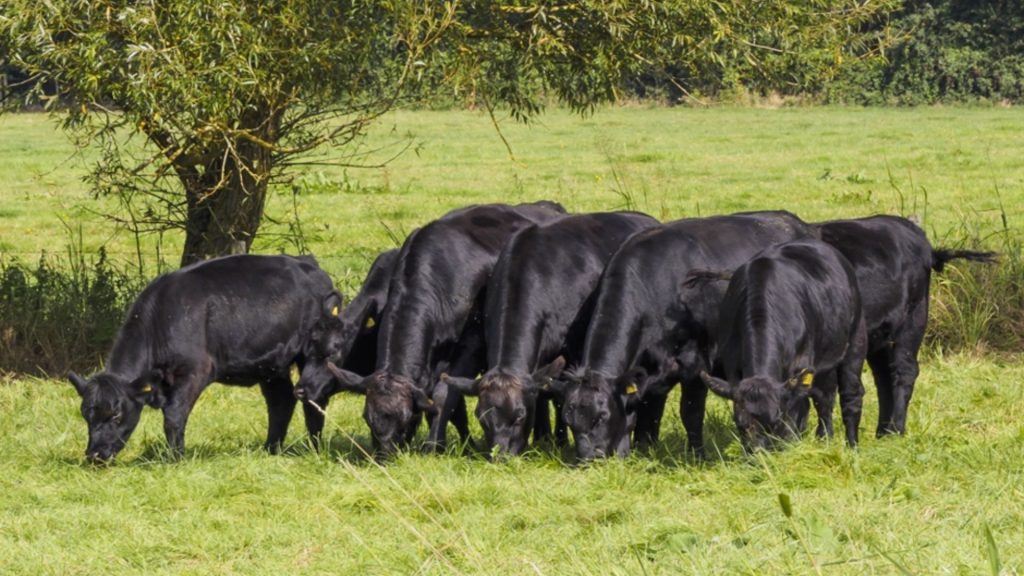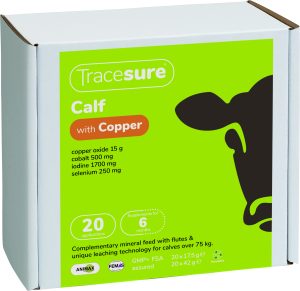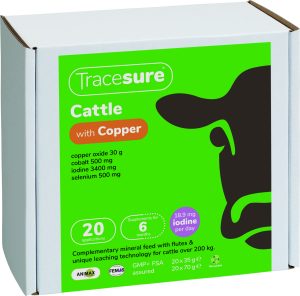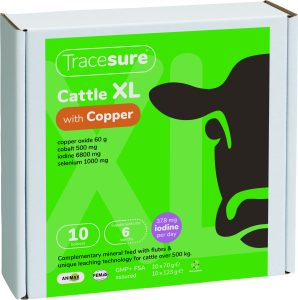The weeks leading up to spring turnout is when we should be thinking about proactively preparing cattle for optimal performance off grass. Matty Gray puts the lens on beef cattle supplementation strategies ready for spring turnout.
The backbone of beef nutrition at turnout is providing sufficient water, energy, and protein – all of which are generally available in well-managed spring grass.
However, spring grass isn’t always sufficient in trace elements. Cattle deficient in any of the key trace elements will have compromised performance.
Trace element status of forages depends on various factors including soil type, drainage, pH, and plant species. This can all vary from farm to farm and even field to field. Therefore, cattle on forage-based diets are most likely to be at risk of trace element deficiency.
According to Meat Promotion Wales, copper, cobalt, selenium, and iodine are the most important trace elements for cattle and sheep in England and Wales, and this is likely the case for UK and Ireland.
So, let us look at the roles of these trace elements known to be essential to cattle growth and fertility during turnout (well, all year round).
The role of copper in beef cattle
Copper is required by many enzymes, which explains why many different deficiency symptoms are seen. Copper is also required in larger amounts than cobalt, iodine, and selenium.
A deficiency in copper will show itself in various ways, depending on which enzymes are depleted first. The most reported symptoms are poor growth in the youngstock and poor fertility in the cows. Hair discolouration, hair loss, and white ‘spectacles’ around the eyes can be observed in deficient cattle.
The role of selenium in beef cattle
Selenium is involved in the recruitment of white blood cells which have a key immune function, along with vitamin E. Selenium plays an essential role in the conversion of the thyroid hormone to an active form. In simple terms, selenium is essential for immunity related to cow and calf health.
While white muscle disease is perhaps the most widely recognised clinical sign of deficiency, but the clinical and subclinical impacts on health, fertility, and growth must be considered. Specifically, low sperm motility, increased incidence of retained placentas, negative effects on embryo fertilisation, and even poor responses to common bacterial infections such as mastitis or diarrhoea.
The role of iodine in beef cattle
Iodine has a significant role in the production of the thyroid hormone, and consequently – all metabolic functions and growth. All body functions from regulation – foetal development, and muscle control, and fertility – rely on this hormone. Thus, sufficient iodine is vital.
Iodine deficiency symptoms in the beef herd will vary and can present in the same way as an excess supply of iodine. Commonly reported symptoms are failure to thrive in calves and poor vigour in newborn calves and even goitre (enlarged thyroid gland). There can be an impact on fertility and retained placentas after calving.
The role of cobalt in beef cattle
Cobalt has a key role in the ruminant. Primarily, cobalt provides the starting block for the rumen microbes to make vitamin B12. This vitamin is absorbed from the rumen into the blood stream and forms a structural component of key enzymes involved in the rumen energy cycle.
Cobalt deficiency is less common in cattle compared to sheep but can still occur under certain conditions. For example, ruminal acidosis when the rumen flora is disrupted or with parasite burdens and changes in diet and energy source to the ruminant. Cobalt deficiency is less common in adult cattle due to the greater reserves in the body and that rumen disturbances are less common.
Trace element deficiency signs at a glance
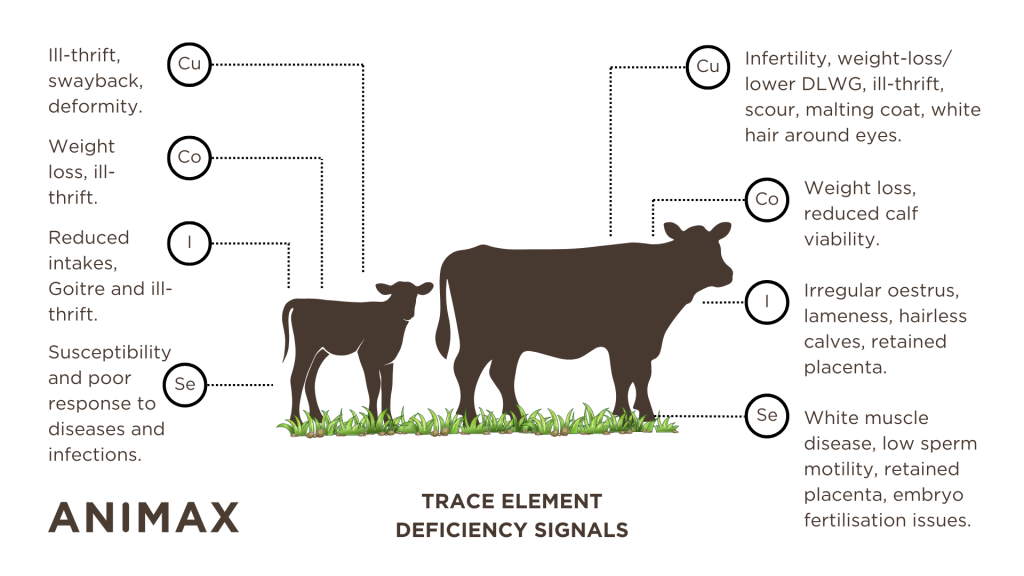
Do a trace element analysis before turnout
Once the animal’s trace element requirements have been calculated alongside the trace element supply from the available feedstuffs (in this case, grass), work with your vet or SQP to establish the trace element gap that needs to be filled during turnout.
- Soil sampling before turnout gives an indication of the trace element status and presence of any antagonists.
- Forage analysis for energy, macrominerals and trace elements will also give an indication of any soil contamination.
- Tissue samples of fallen stock or blood samples of livestock on farm will provide a very accurate snapshot indication of the current status and identify likelihood of deficiencies in a group.
Why you should bolus before turnout
Once supplementation gap risk at turnout is known, select a strategy to supply the right trace elements in the right amounts ready for turnout.
There are many different forms of supplementation to choose from. When shopping around, understand that there is no one-size-fits-all approach. From group to group, and from farm to farm, there is a place for mineral buckets, blocks, bags, and boluses.
That said, do not chuck everything at your cattle in an ‘insurance-scheme’ type of approach. This can cause unnecessary costs and can even cause toxicity. Put simply, oversupply is as dangerous as undersupply. It’s important to supply enough – not too much and not too little.
On an AHDB trial study across 6 suckler beef and sheep farms in England and Wales, the ideal outcome always pointed to the efficacy of bolus technologies.
- 1 farm switched to bolusing,
- 1 farm was considering switching to bolusing, and
- 4 farms added bolusing to their supplementation strategy plans.
A bolus ensures every animal is turned away with enough of a supply every day. No if’s, but’s or maybe’s.
ANIMAX Tracesure®
Developed with decades of science and research, ANIMAX Tracesure® supplies enough cobalt, copper (optional), iodine, and selenium for up to 6 months, taking you through the summer turnout period.
| PRECISE
Features diffusion technology® for a precise release of trace elements and low chance of premature passing. |
EFFECTIVE
Contains a form of cobalt, copper, iodine, and selenium selected for their effective utilisation properties. |
EASY
Lasting for up to 6 months and bolused in 1 application, it’s a quick solution and one less variable to worry about. |
ANIMAX Tracesure® Calf
For ruminating livestock above 75kg. In practice, suckler calves are usually bolused at around 10+ weeks based on their rumen development.
ANIMAX Tracesure® Cattle
For ruminants of 200kg and over. Generally, this is our go-to bolus for growing cattle, finishing cattle, or breeding stock.
ANIMAX Tracesure® Cattle
For ruminants of 200kg and over. Generally, this is our go-to bolus for growing cattle, finishing cattle, or breeding stock.
5 pointers for optimal turnout
- Animal health plan – Plan with your advisor how you will manage parasite, clostridial disease, and foot health through the grazing season.
- Forage – Consider measuring grass to calculate supply and appropriate stocking density to ensure quality and quantity is maintained through the year.
- Fertilising – Apply phosphate and nitrogen in the spring to help ensure the grass gets off to the best possible start, while also ensuring soil pH is also ideal.
- Water – Make sure your water troughs are working, cleaned out as required, and flow is adequate to ensure feed intakes.
- Staggers – Be wary of applying Potash-rich fertilisers or manure in the spring, especially in cold and wet weather conditions.

